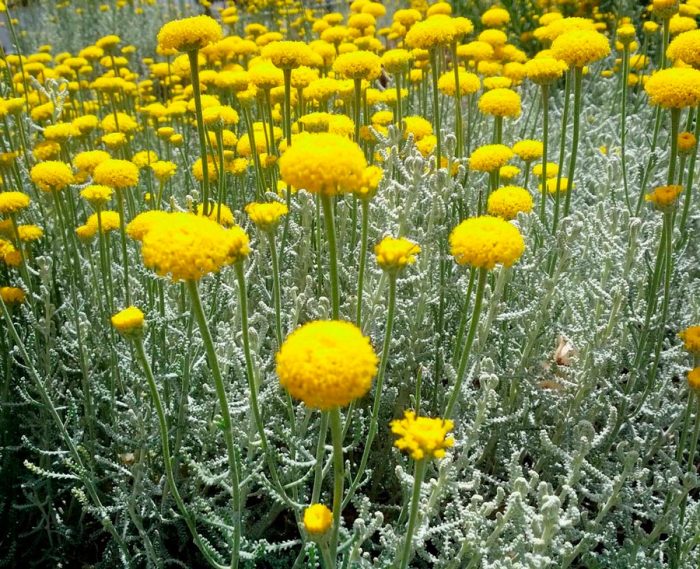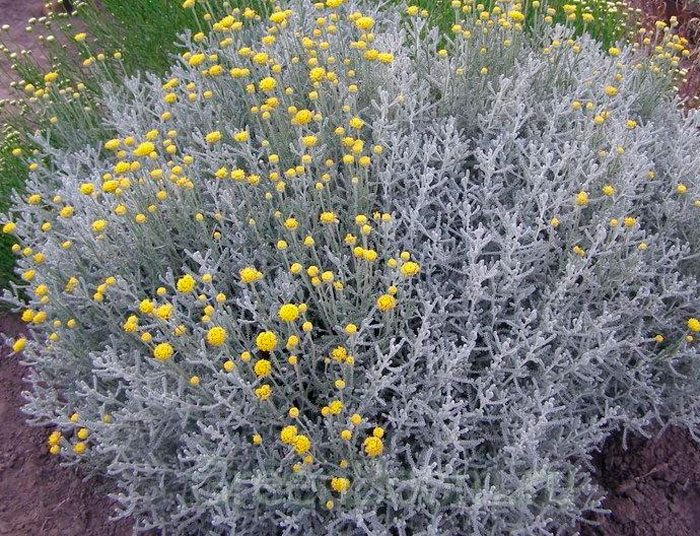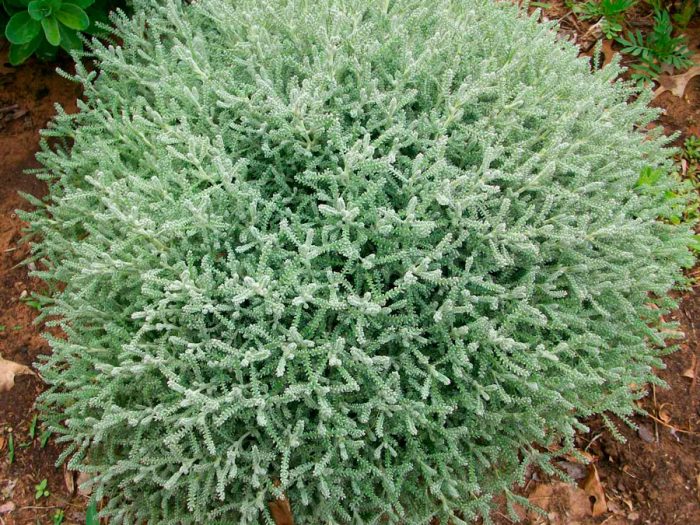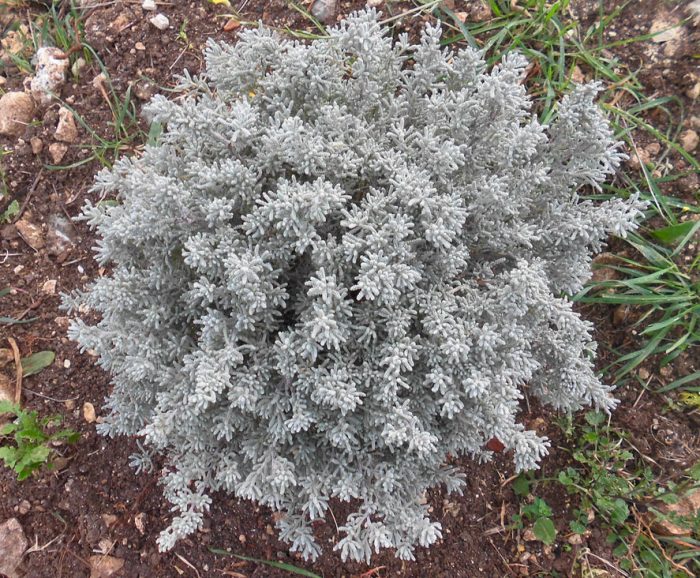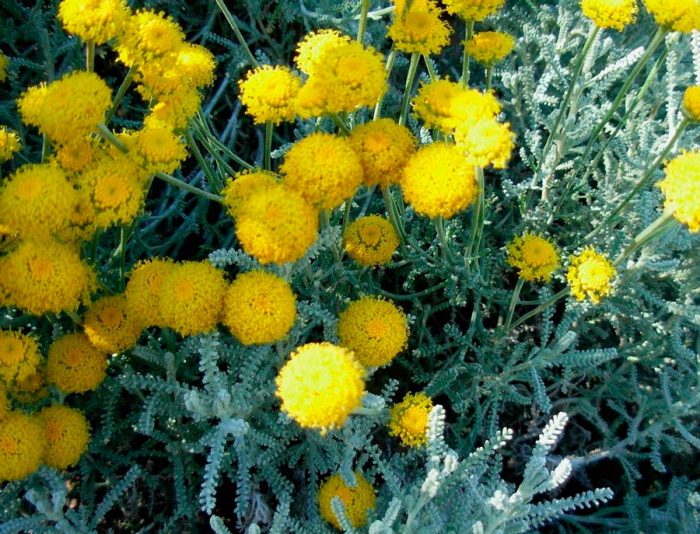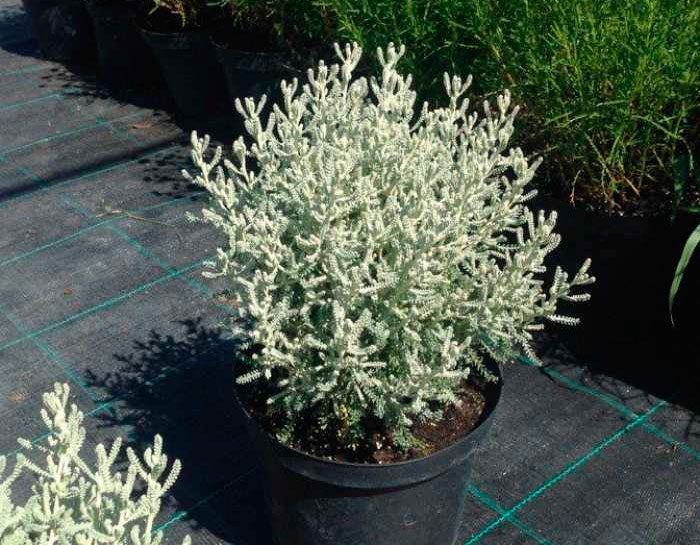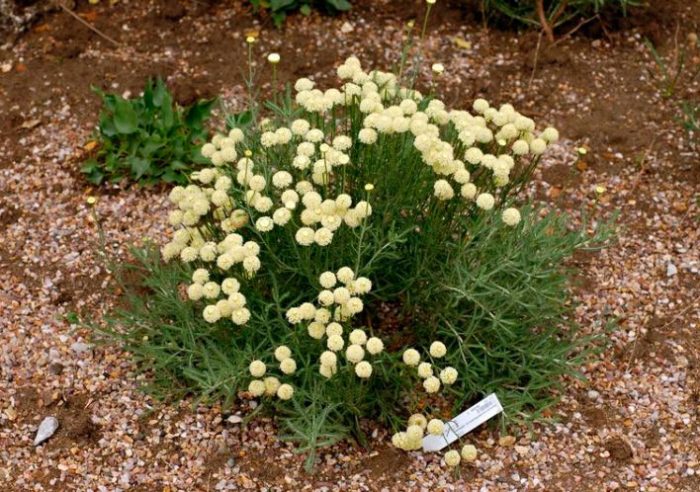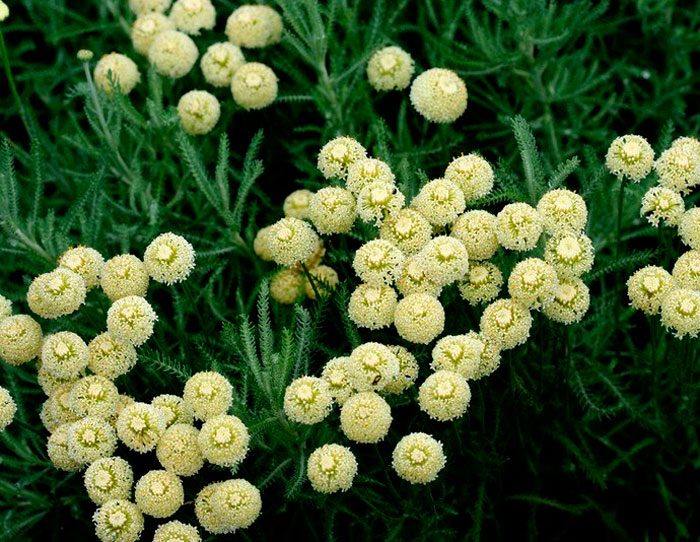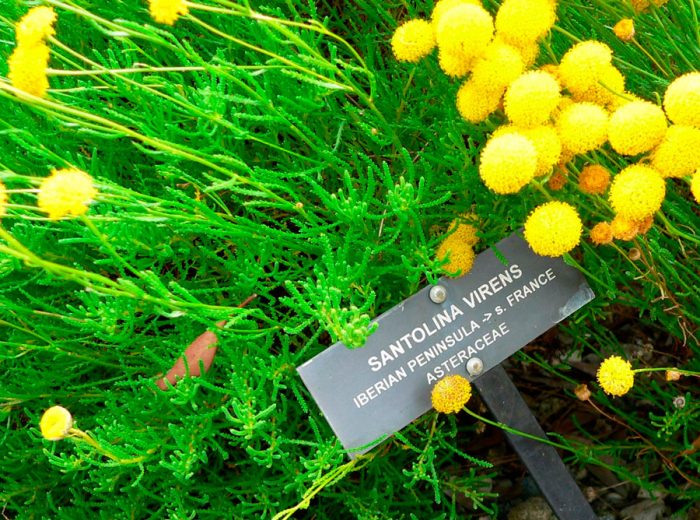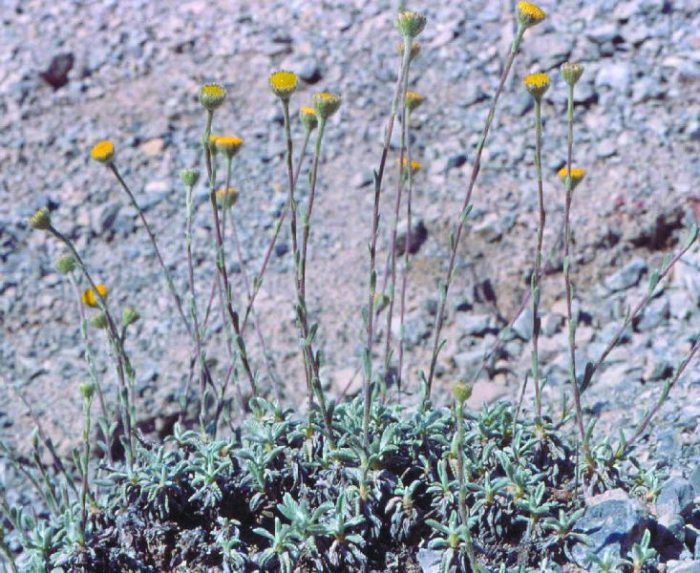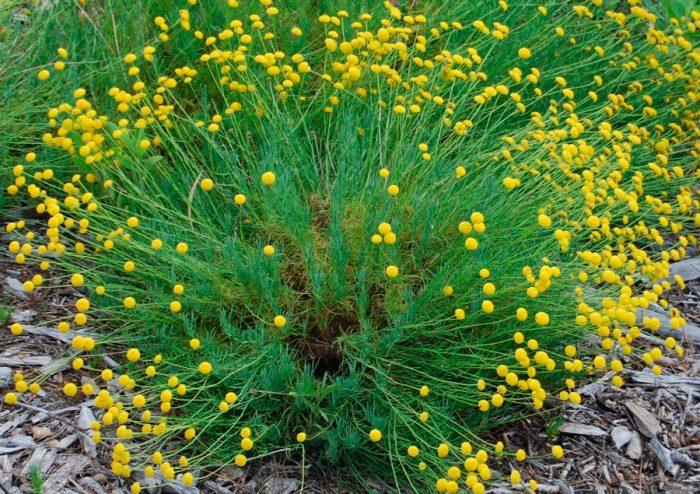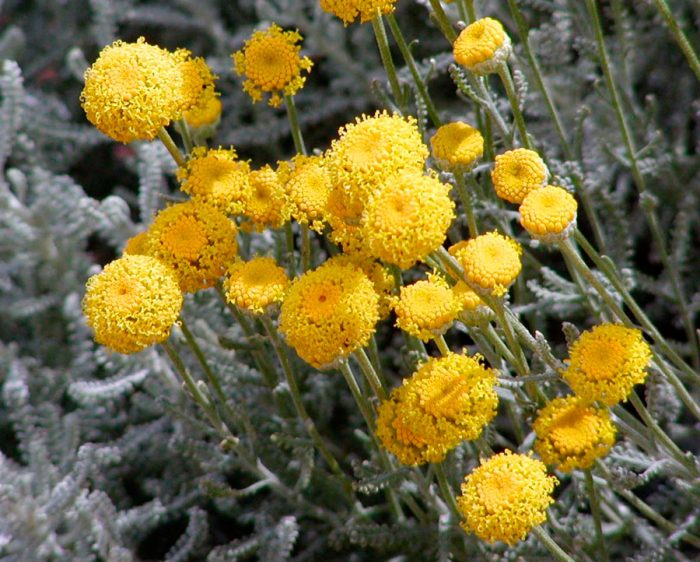The fragrant evergreen shrub Santolina is a member of the Asteraceae or Asteraceae family. Under natural conditions, such a plant can be found in the southern part of Europe. According to information taken from various sources, this genus unites from 5 to 24 species. This plant is very compact, thanks to which it is cultivated both in the garden and indoors. In some species, foliage is used as a spice additive, and is also used as a moth repellent.
Content
Features of Santolina
The height of santolina varies from 0.1 to 0.6 meters. On the surface of feathery or simple (in some cases, long) leaf plates there is a light gray fluff. Thin stems rise above the foliage by 10-25 centimeters, in their upper part there are flowers collected in yellow or white dense spherical inflorescences, reaching about 20 millimeters in diameter. The inflorescences and foliage of this plant are fragrant, since it also contains essential oils. Bloom is observed from June to August. This culture, which has a high decorative effect, is grown on slopes, crushed stone beds, and also in rocky gardens.
Planting santolina outdoors
What time to plant
For planting santolina, it is recommended to choose a well-lit open area that has protection from the wind. When grown in a shaded place, the bushes become elongated, lose their shape, they look loose and sloppy. The soil suitable for planting should be moderately dry, and still have good water and air permeability. If moisture stagnation is observed in the soil, then the bushes quickly die. Therefore, wet clay soil is not suitable for growing santolina. On scanty soils, the flowering of this plant is most magnificent. If it is grown on fertile soil, then the bush will grow strongly, but it will bloom poorly. Neutral rocky or sandy loam soil is best suited for growing this crop. It should also be taken into account that the groundwater at the site must lie quite deep.
Before proceeding with planting, the soil in the selected area must be dug up. If the soil is heavy, then during digging, crushed stone or fine sand should be added to it, which will increase its drainage.
Santolina is grown through seedlings. Sowing seeds is carried out in the last days of February or the first in March. However, before you start sowing, the seeds need to be stratified by placing them on a refrigerator shelf for vegetables, where they must stay for 4-8 weeks.
Landing rule
Sowing of seeds is carried out in boxes filled with light, slightly moist soil. The crops should be covered with foil from above, and then they are removed to a warm and well-lit place. The first seedlings should appear 15–20 days after sowing. Seedlings need to be provided with exactly the same care as for seedlings of other plants. Plant picks are made after the second or third true leaf plate begins to form in them, for this, individual peat-humus pots or cups are used. After the plant grows stronger, they need to be hardened, and then transplanted into open soil, they do this in the last days of May or the first in June. Landing takes place on a rainy day or in the evening after sunset. The size of the planting pits should be such that the system of plant roots, taken together with a lump of earth, fits in them. Planted plants should be watered using very little water. After moistening, all voids in the soil should disappear.
Caring for Santolina in the garden
Growing santolina in your garden is easy enough. For this, the bushes must be provided with timely moderate watering, loosening the surface of the earth near the plants, removing weeds, feeding, picking off wilted inflorescences, and also preparing the plants for winter in time.
How to water and feed
Watering should be systematic and moderate. This plant is highly drought tolerant. If it rains regularly in the summer, then the bushes can do without watering. However, during a prolonged dry period, they will need systematic watering. If the stems of this plant turn yellow in the middle of the summer period, then this is the fault of stagnant moisture in the root system. To fix this, you need to leave the flowers un-watering for a while. It should also be noted that watering should be done only when the top layer of the earth dries out well.
Top dressing of santolina is carried out during intensive growth 1 time in 7 days. The application of a solution of mineral fertilizers with a small amount of nitrogen begins in spring after the intensive growth of the bushes begins. In August, you need to stop fertilizing the soil. The nutrient solution should be very low in concentration, since the presence of a large amount of nutrients in the soil has an extremely negative effect on flowering.
How to propagate and transplant
If you grow santolina in the same place without transplants, then its degeneration begins. In this regard, transplanting bushes is required every 5 or 6 years in the spring. During transplantation, the division of the bush should also be carried out.
Bushes should be removed from the ground and divided into parts, while taking into account that on each division there should be stems and part of the rhizome. Places of cuts should be sprinkled with crushed charcoal. Delenki are planted in planting holes, which should be prepared in advance. They are buried in the soil up to the point where the branching of the stem begins. In the autumn, it is recommended to huddle the bushes high, due to this, by the time of transplantation, young branches are formed at the bush.
You can also propagate such a culture by cuttings. They are harvested in March, for this you need to cut off the shoots of this year from the bush. Places of cuts are dipped in a solution of an agent that stimulates the formation of roots, after which the cuttings are planted in sand, and covered with a film on top.After the growth of young leaf plates begins on the cuttings, they will need to be seated in individual containers. Until June, they should grow up and get stronger, after which they are planted in a permanent place.
Wintering
When the plant finishes blooming in August, the stems will need to be shortened by 2/3 of the length. Thanks to this, the shape of the bush will remain neat, and it will not fall apart. When growing this crop as an ornamental deciduous or spicy plant, its inflorescences must be cut off before they wither. Santolina has a low resistance to frost and when grown in mid-latitudes in frosty winters can die. To avoid this, the bushes must be covered. To do this, they must be covered with a large wooden box on top, which is covered with spunbond, roofing material, lutrasil or film. The covering material must be fixed with something heavy, for example, bricks, otherwise it can be carried away by the wind. However, before placing the box, the surface of the earth near the bush is covered with a layer of needles, spruce branches or sand mixed with wood ash. In spring, the shelter must be removed, and after the snow cover melts, the surface of the site is covered with compost mulch. Some gardeners take out santolin from the ground for the winter and plant it in a pot, which is placed in a cool room. In the spring she is planted again in the garden.
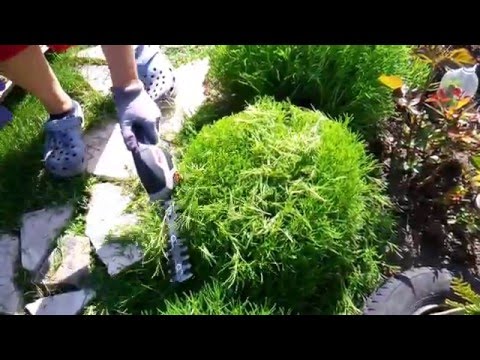

Watch this video on YouTube
Diseases and pests
Santolina has a very high resistance to diseases and pests. However, if stagnation of water is observed in the soil, this will cause the manifestation of rot on the root system. In the case when the shoots turn yellow ahead of time, you can be sure that this is due to the stagnation of water in the soil. The bushes need to be spilled with a solution of a fungicidal preparation, then they are not watered for a while. After a while, the plants will become beautiful and healthy again.
If the bushes grow in a shady place, then this can also cause problems with them. Despite the fact that this crop is drought tolerant, it still needs to be systematically moistened, otherwise it may die in dry soil.
Types and varieties of santolina with photos and names
Gardeners cultivate 5 or 6 types of santolina, each of which has its own disadvantages and advantages.
Santolina neapolitana (Santolina neapolitana)
This species is the most vigorous, the height of the bush can reach up to 100 centimeters. This species has dwarf varieties Pritty Carol and Weston, which reach a height of only 16 centimeters. The inflorescences are spherical and yellow in color. They look spectacular against the green background of dissected leaf plates. Since this species is thermophilic, it is cultivated most often in an alpine greenhouse.
Santolina pinnata
The height of the bush is about 0.6 meters. The length of the narrow leaf plates is about 40 mm. On long peduncles, spherical inflorescences of cream color flaunt.
Santolina greenish, or greenish (Santolina virens)
This species is distinguished by the greatest endurance, it is able to withstand frosts up to minus 7 degrees. This species, unlike others, has pinnately dissected openwork green leaf plates. Due to this, from a distance, the bush can be mistaken for a thick, pale green fog. Foliage and young shoots of this plant are often used as a seasoning for dishes. White-milk inflorescences have a spherical shape.
Santolina elegans
This species is distinguished by its whimsicality and demanding air temperature. At the same time, the compact and graceful bush looks very impressive. It is suitable for indoor or greenhouse cultivation. Above the bush, on long peduncles, inflorescences-baskets of a spherical shape and yellow color rise.
Rosemary santolina (Santolina rosmarinifolia)
Thin long pinnately dissected leaf plates have a spicy olive scent. Essential oils are found in any of the parts of this species, so this santolina is most often cultivated as both a spicy and an ornamental plant.
Cypress santolina (Santolina chamaecyparissus), or silvery santorina
This type is most popular with gardeners. The compact and fragrant bush reaches a height of 50 centimeters. It has arched stems and blooms very luxuriantly. While the feathery leaf plates are young, they are painted greenish, which, over time, as the bush ages, changes to grayish-silver. The inflorescences are spherical and yellow in color. This species blooms from July to August. Such a santolina has dwarf varieties Small Nels and Nana, and there is also a variety Edward Bowers, whose inflorescences are painted in cream color.
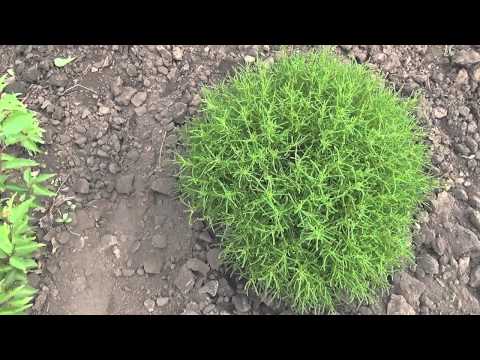

Watch this video on YouTube

